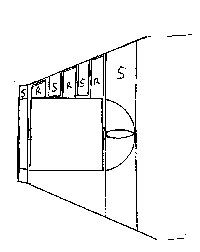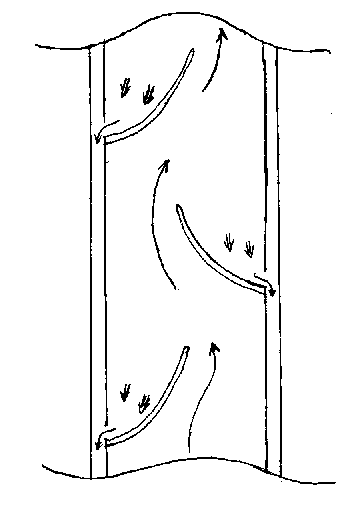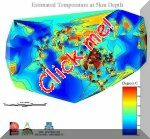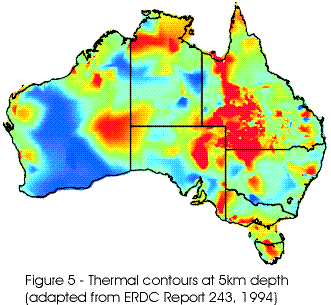
Welcome, from sunny Australia!
 The
Geothermal
Power Plant in more detail
The
Geothermal
Power Plant in more detail

 The
Geothermal
Power Plant in more detail
The
Geothermal
Power Plant in more detail
Quick link to -
- Ok, how the whole thing
is supposed to work ...
- Construction
- How much power?
Intro
I sat down a short while ago, (as I write
this) and decided to figure out just how to make the turbine method of
power generation actually work, rather than just give a general
description on the previous page. I thought it wouldn't be that hard to
do, but after a fair amount of thought I realised that there are
difficulties with having a closed system and also getting a
decent pressure differential to make the turbine work well. (enough)
So, I had to have a bit of a re-think, and
this is what I came up with ...
The main shaft would be the same diameter,
but would be divided into two main sections, both vertically and
horizontally. The shaft would have a smaller shaft one one side, for
reasons that I'll explain shortly. The main shaft would also be divided
up into the lower, power generating section, and the upper, water
condensor/collector section.
The basic principle is exactly the same, but
the way that the waste steam from the turbine is ducted is quite
different - It now would travel up that secondary shaft, still picking
up a little heat from the outside rock, until it finally reaches a
point above the power generator section. I'll also explain why it works
like this shortly.
The power section would be made from a
number of small generator modules. Each module would have a large water
tank, that would soak up the heat from the surrounding rock to the
point where it would be giving off large amounts of steam. The 'boiler'
would be sealed until it reaches a minimum of about 1,000psi, so that
the steam pressure would run the turbine at high speed.
This is a simplified schematic of the power
generator module, showing the main components -

1 - The electrical generator. This would
be specially designed to spin at high speed. The weight/inertia of this
wouldn't be too important as once the device had spun up, it would
continue to spin for years to come. I'm basing the electrical power
output of each module on this generator being able to make at least
500kw of power. (read the paragraph on the turbine as to why I reckon
this is about right)
2. By means of a shaft, the generator is
connected to the turbine. (see later picture/paragraph for details)
Just
above the turbine exhaust you can see how the housing bends across to
the side to exit into the secondary ducting, exhausting upwards. Just
below the turbine is the main water pump, which serves two purposes.
The main purpose is to keep the boiler topped up with cold water, and
the secondary reason is for turbine lubrication & cooling.
3. This is the main regulator valve, and it
does two things - Regulates the steam gas flow to control the turbine's
speed, and also keeps the boiler pressure to a minimum of 1,000psi.
4. The boiler. This is one of the very few
metal components (steel, coated to stop corrosion) in the module. I'm
not sure how big the boiler would have to be, but I'd guess about 8
metres long x 1.5 metres wide, which would make it about 33³m in
volume. There'd be an air gap at the top, so there'd only be about
30³m odd of water, thus, about 30 tonnes of weight there. Some
experimentation would be needed here to find out just how large the
boiler would need to be, to make sure that the water supply coming into
the boiler is just enough to keep the water level constant as the water
steams up. It may well end up a lot smaller at the lower levels due to
the higher rock temperatures, but the modules above would need larger
volumes of water, I'd guess, to allow for the longer boiling times.
All the machinery would be supported from
the base of the boiler, with just the single drive shaft from the
turbine to the generator being able to move around with thermal creep.
(by using a splined 'quill shaft') The boiler itself would be held it
place with aluminium brackets, as aluminium conducts heat like you just
wouldn't believe.
5. Secondary ducting. This is where turbine
exhaust flows upwards, to the water collector/condensor section. On
either side of this ducting is the cool water downflow pipes - This is
the return path for the water from the collector section to the power
modules.
Ok, the turbine is the heart of the module, so here it is in a bit more detail -

Ok, how the
whole thing is supposed to work ...
... or, "a day in the life of a drop of
water!" :)
Let's start in the boiler - The outside rock
temperature is up around 350°C, and so since the module would have
been heat soaked so that entire device would also be at around that
temperature, thus heating the mass of water quite well to boiling
point.
All around the skin of the boiler, large amounts of steam would be
bubbling off, rising to the top where the pressure regulator would be
keeping the steam to at least 1,000psi on it's way to the turbine. The
turbine would be spun up to around 30,000rpm, making about 1,000hp in
power, spinning the electrical generator so it makes at least 500kw of
power. The steam, now having lost a fair bit of temperature and
pressure, exits the module at a a temperature somewhat less than the
outside rock but still at high speed and with a relatively large
volume, thus making rise up the secondary shaft.
Since the steam would remain as steam until
the rock temperature is less than about 100°C, it would rise for a
couple of kilometres, up where the water condensor/collector section
is.
This section is dead simple, and looks a little like this -

Anyway, back to the water flow - the down
pipes would go down all the way to the bottom of the main shaft.
However, only one pipe would be full to the bottom, (this one being
only full half way) and the other one only being full to the halfway
point down the power section. The reason for this is so as to not have
a huge pressure differential along the length of each pipe into each
power module - There would be at least 100 modules over a single
kilometre, so the difference in water pressure from top to bottom would
be quite large. I figure the solution would be to have one pipe feeding
the lower half of the modules and the other pipe feeding the top half,
thus minimising the pressure differential.
In any case, the pipes would be full enough
so that the pressure at the bottom of each pipe would be just lower
than
the boiler pressure. This is to make sure that the water pump on the
bottom-most module doesn't have to constantly regulate 'backwards'
against the water pressure. The down pipes would have to be well
insulated against the high rock temperature, so as to deliver the water
below 100°C. (Note that as the depth increases, so does the outside
air pressure, and so does the boiling point of water; roughly 1°C
per 300 metres.)
The water pump would then pump liquid water
back into the bottom of the boiler, whilst regulated to keep the water
level to a pre-set point to keep a good air gap at the top of the
boiler.
Thus the cycle starts again.
It'd also be very easy to get the system
working after it's been built - Simply throw a hose over the edge of
the
hole and turn the tap on for a while ... ;) It would take a while
for the boilers all to settle down to whatever level they're happy
working at, but power would start being generated as soon as the first
(lowest) boiler made steam.
Construction
I've thought about what material would be
best for the construction of the main shaft, module framework, etc.
What
is needed is a material that's cheap, easy to shape, and resistant to
~400°C. I figure that plain ol' concrete would do the trick!
Since the main shaft would have to be dug
then lined with concrete, I picture the best way to do this would be to
cast concrete 'shells', each one making up 1/3 of the circumference of
the shaft and designed so that they can slip together from being
transported down the centre of the main shaft. They'd be locked in
place with a few steel pins hammered into the rock.
The power modules framework would also be
best made from cast concrete. With the cast concrete sections, I think
that it would be best if they were cured after casting in an autoclave,
under high pressure and temperature so they would be stabilised for the
conditions they'd be experiencing for quite some time afterwards.
As mentioned before, the turbine would best
be made from ceramics, to give the longest life and maintenance free
service.
The electrical generator would be a bit of a
problem, as conventional soldering couldn't be used as the ambient
temperature would melt any of the usual joints, so, mechanical joints
would have to be used. That makes life a little more difficult, but far
from impossible.
The top of each power module would match up
with the bottom of the one above, with small electrical motors driving
the seals for the water, electrical cables, and data & controller
cables.
There are two computer controlled valves,
one for the boiler outlet and the other for the water flow into the
boiler. Both would need very reliable electric motors to drive
the valves.
All the computer power to control each
module would be up on the surface, so no special heat resistant boxes
would be needed for them. (each module would be controlled be means of
a discreet code, so there would need to be a very basic chip at each
valve, along with temp & press sensors, but they are very basic
devices that're quite rugged compared to 'number cruncher' computer
chips)
There's really only about four moving parts,
so I believe that the modules would be extremely reliable in the long
term ... which is good, because it would be rather time
consuming to get the very bottom one out of the shaft! ;)
How
much power?
I am making some very rough assumptions,
based on my experiences with aircraft jet engines, but I hope that
you'll agree with my reasoning.
One aircraft I flew had a Garret
TPE-331-10UA turboprop engine. I've seen the turbine section out of the
aircraft on a work bench, and I could easily hold it in one hand - They
make about 3,000hp, (~2,200kw) of which about 2,000hp is used to drive
the compressor and accessories, leaving about 1,000hp to drive the
propellor. In my mind's eye, I picture the turbine used in this
geothermal power system to be about three times larger than the Garret
one, but the power that the steam has would be quite a bit less than
the power of the combustors of the Garret, however, this is well and
truly compensated for by the fact that the load on the ceramic turbine
is a LOT less than on the Garret, and I also think that using the trick
of making the turbine wider than the Garret's the power output would
not be too far off the aircraft's 2,200kw, but to be terribly
pessimistic I'll call it 500kw.
I'd say that each power module would be
about 10 metres long, so 100 of them could be fitted every kilometre of
the shaft. If you only use the last one kilometre of the shaft, then
that's at least 50 megawatts of power for basically nothing!
If we are a little more optimistic with some
of the assumptions, say, 1,000kw for each module, and have 250 per
shaft, then you're up to a good 250 megawatts.
I'd say that the practical power figure lies
somewhere around ... 100 megawatts?
Of course, that's just the one shaft - They would only take up the size of a small house on the surface, so there's no reason why a new shaft couldn't be dug every kilometre or so, thus having a relatively small amount of land generate a lot of power.
One thing that I dug up (pun intended!) that supports the amount of heat below the surface is the picture below.

And here's a similar view, but
easier to see.

It's from here, and it clearly shows the huge amount of energy available, especially just down the road from where I live in Australia.
Back to the previous page